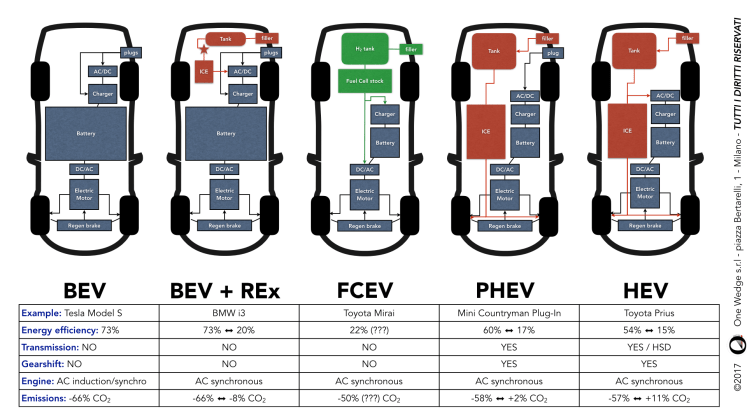Since there are numerous configurations of electric vehicles (EV) we thought of arranging the various types in a single infographic:
 .(please note these are simple block diagrams)
.(please note these are simple block diagrams)
Click here to download a higher-resolution PDF
- BEV (Battery Electric Vehicle) – in this configuration, electric energy enters the vehicle as alternate current (going through an AC/DC converter) or direct current, according to the type of charger I am connecting: the internal charger charges a large (tens or, soon, hundreds of kilowatt-hours). From here it goes through an inverter to be fed to the electric motor, typically AC synchronous or – more rarely – induction). Wheels are also connected to a generator for the recuperation of energy when braking.
- BEV + REx (Battery Electric Vehicle + Range Extender) – this vehicle is laid out exactly like a BEV with the addition of a small gasoline generator to charge the battery when needed. Unlike the HEV configuration, however, this generator does not switch on automatically and the generator and attached tank capacities are very limited. Moreover, the generator is not capable of moving the wheels: its sole function is to charge a depleted battery.
- FCEV (Fuel Cell Electric Vehicle) – this vehicle only has an electric propulsion system, with the electric energy coming from the fuel cell stack where hydrogen is oxidized; such energy can be fed either directly to the electric motor or to the small battery.
- PHEV (Plug-in Hybrid Electric Vehicle) – this configuration has almost universally replaced the HEV layout from which it derives, replacing its internal battery charging to grid-based charging, typically only in AC.
- HEV (Hybrid Electric Vehicle) – in hybrid configurations, the vehicle carries both an internal combustion and an electric propulsion systems: for space and weight reasons, the latter uses a small battery (a few kWh); both are capable of moving the car, and the control electronics decide which one intervenes, a mixed drive being also possible. In this closed-cycle type, the battery is charged solely by the ICE motor or by regenerative braking.
METHODOLOGICAL NOTE:
For each configuration, we indicate an energy efficiency parameter and an estimate for the reduction of emitted CO2. These numbers were derived as follows:
- we started from this estimate for the efficiency of electric and ICE motors and this estimate of CO2 emission reduction;
- efficiencies and reductions were weighted for two electric mileage ratios scenarios (10% and 90%) to obtain a maximum and a minimum;
- for PHEV and HEV hybrids we added an arbitrary 10% penalization to account for the extra weight
- only for HEVs, we introduced a further 10% penalization to account for the fact energy is produced inefficiently (small generator)
For the FCEV vehicle efficiency and reduction are question-marked because they depend critically on the process to manufacture molecular hydrogen which – as we all know – does not exist anywhere on our planet.
CREDITS
This article was collectively written with the collaboration of numerous – too numerous to be listed here individually – electric mobility fans in a co-authoring exercise which proves social media can actually be used for worthwhile purposes 😀
Want to keep abreast of eMobility News? Subscribe to Sparklers!, our free monday morning email newsletter

Una risposta a "An EV taxonomy"